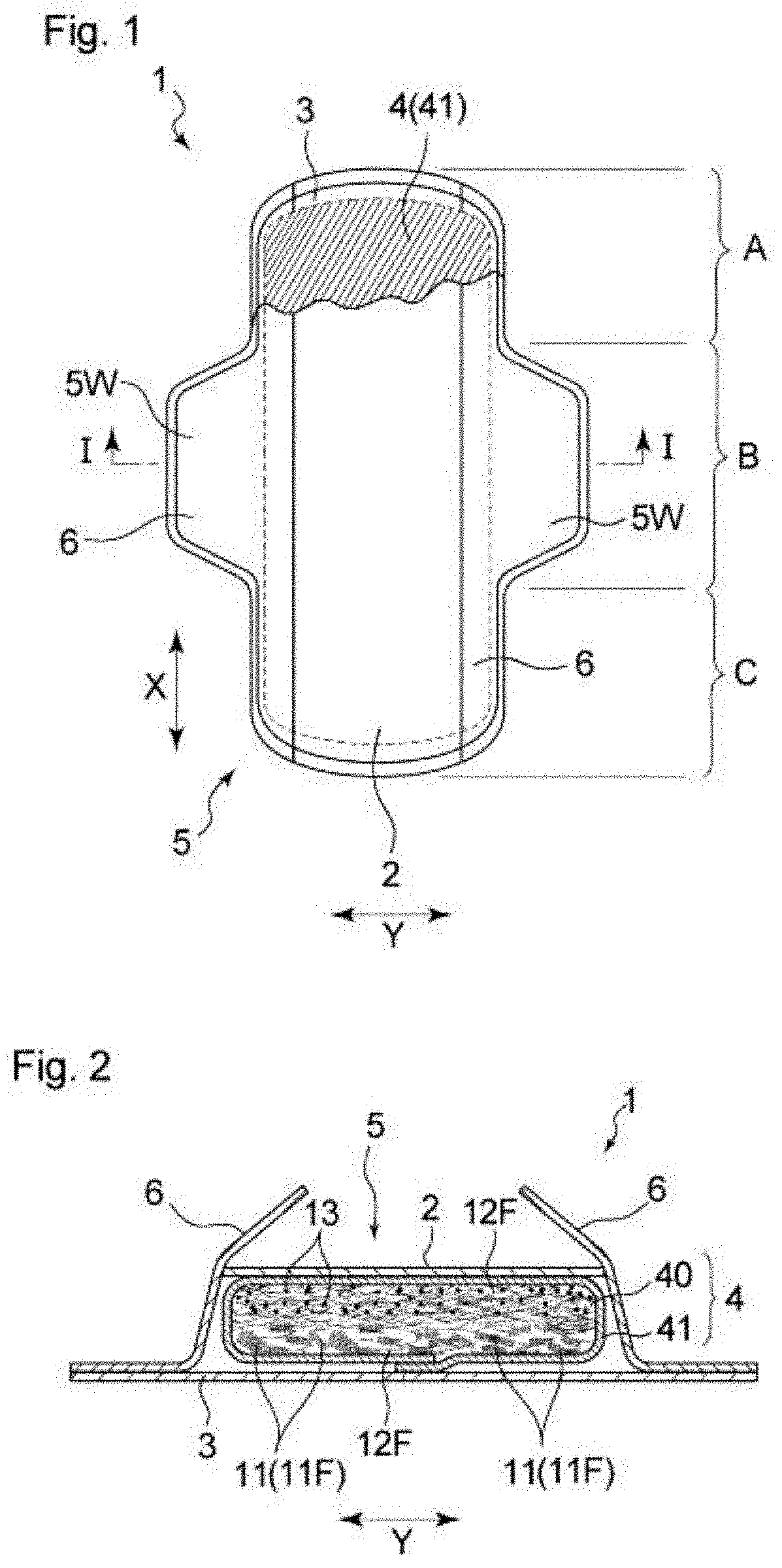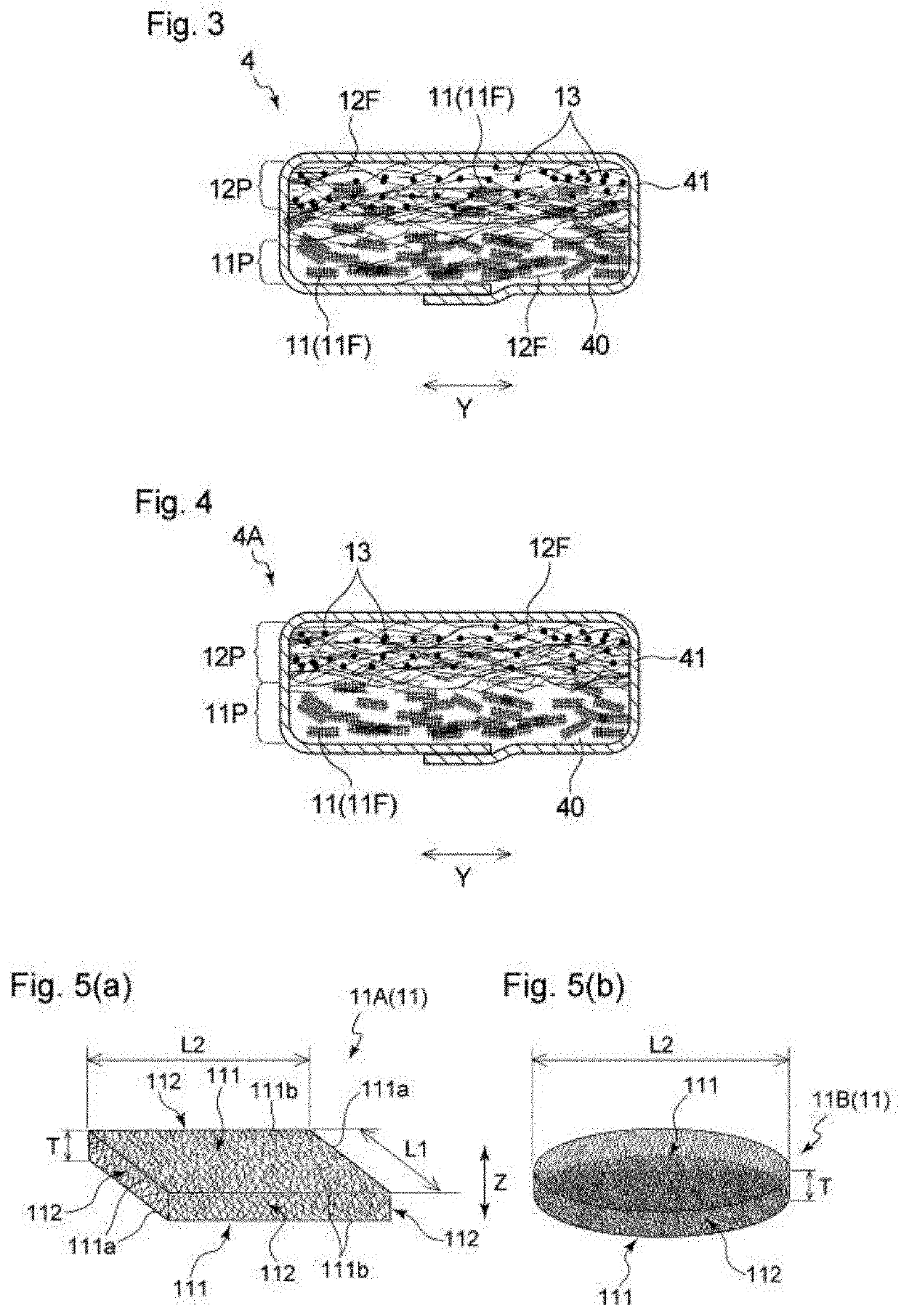Absorbent body and absorbent article
a technology of absorbent articles and absorbent parts, which is applied in the field of absorbent parts, can solve the problems of not specifically revealing the shape and the like of the small pieces of nonwoven fabric used in the cushion layer, and the absorbent member used in the absorbent article has major problems of improving various properties
- Summary
- Abstract
- Description
- Claims
- Application Information
AI Technical Summary
Benefits of technology
Problems solved by technology
Method used
Image
Examples
example 1
[0173]A sanitary napkin having substantially the same basic configuration as that of the napkin 1 shown in FIG. 1 was prepared.
[0174]As a topsheet, an air-through nonwoven fabric having a basis weight of 30 g / m2 was used, and as the backsheet, a polyethylene resin film having a basis weight of 37 g / m2 (FL-KDJ100nN, manufactured by Daika Kogyo Co., Ltd.) was used. An absorbent member was produced by a common method with a known fiber stacking apparatus by using fiber clusters and water absorbing fibers as the fiber materials of an absorbent core and using a separately prepared core-wrap sheet of tissue paper having a basis weight of 16 g / m2. To produce the fiber clusters, a material fiber sheet was cut into dice in accordance with FIG. 6. The arrangement of fiber materials (fiber clusters, water absorbing fibers) in the absorbent member of Example 1 was, as with the absorbent member 4 shown in FIG. 3, that the fiber cluster occupancy or the fiber cluster ratio gradually increased fro...
example 2
[0182]The same procedure as in Example 1 was performed except that the arrangement of fiber materials (fiber clusters, water absorbing fibers) in the absorbent member was, as with the absorbent member 4A shown in FIG. 4, that two portions different in fiber cluster occupancy or fiber cluster ratio were arranged in the thickness direction, giving a sanitary napkin as Example 2. In other words, the absorbent member in the sanitary napkin of Example 2 included a water absorbing fiber rich portion 12P as the skin-facing surface side and a fiber cluster rich portion 11P as the non-skin-facing surface side. The portions 12P and 11P were bonded to each other on the interface therebetween by interlacement of the constituent fibers, and the interface is located at the center of the absorbent member in the thickness direction.
example 3
[0183]The same procedure as in Example 2 was performed except that in the absorbent member, the water absorbing fiber rich portion 12P had a fiber cluster occupancy of 0% by mass, or the skin-facing surface side of the absorbent member had a water absorbing fiber content of 100% by mass, and the fiber cluster rich portion 11P had a fiber cluster content of 100% by mass, or the non-skin-facing surface side of the absorbent member had a water absorbing fiber occupancy of 0% by mass, giving a sanitary napkin of Example 3.
PUM
| Property | Measurement | Unit |
|---|---|---|
| water contact angle | aaaaa | aaaaa |
| thickness | aaaaa | aaaaa |
| content mass ratio | aaaaa | aaaaa |
Abstract
Description
Claims
Application Information
 Login to View More
Login to View More - R&D
- Intellectual Property
- Life Sciences
- Materials
- Tech Scout
- Unparalleled Data Quality
- Higher Quality Content
- 60% Fewer Hallucinations
Browse by: Latest US Patents, China's latest patents, Technical Efficacy Thesaurus, Application Domain, Technology Topic, Popular Technical Reports.
© 2025 PatSnap. All rights reserved.Legal|Privacy policy|Modern Slavery Act Transparency Statement|Sitemap|About US| Contact US: help@patsnap.com



